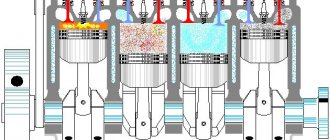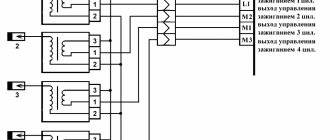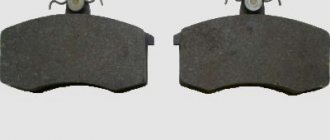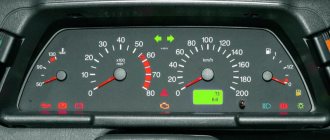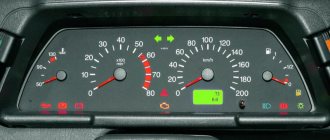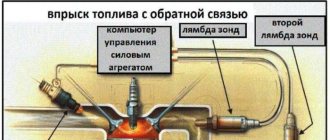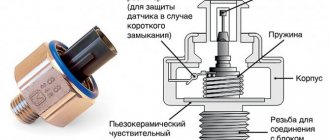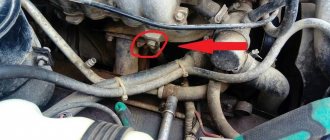It is unlikely that any motorist will be happy with the fact that the Check Engine light comes on on the dashboard. Often this does not bode well.
Yes, sometimes false alarms occur, and in reality there is no malfunction. But in most cases there are problems. They can be determined by the characteristic behavior of the car, as well as by reading error codes recorded and stored in the memory of the control unit.
It is enough to connect to the ECU with a diagnostic scanner or use a smartphone to connect to the unit. A universal error coding scheme allows you to understand what kind of malfunction we are talking about or at least in which of the many systems to look for it.
One of the unpleasant errors is considered to be code P0300. The motorist should know what it means, what caused it and how to fix it.
What does error P0300 mean?
The code in question is directly related to malfunctions on the part of the ignition system.
Error P0300 indicates the presence of misfires in the ignition system, that is, the ignition order is disrupted.
Also, such a malfunction can be described as random multiple misfires that were detected in the ignition system. This is if we take the translation of the English message as a basis. A literal translation yields a similar explanation. This problem is expressed in the form of code P0300 when scanning the memory of the control unit.
If multiple random leaks are detected in the system, the air-fuel mixture ignition system will not be able to function normally. The P0300 error that appears indicates this, helping the driver roughly understand what to look for and in which area to look for a fault.
Error P0300 on some cars varies from 0300 to 0312.
This is due to the fact that certain electronic control units can independently detect in which specific cylinder misfires are recorded. Depending on the final digit in the error code, the motorist understands which cylinder should be entered.
For example, if the engine has 6 cylinders, then the error will vary from 0300 to 0306. If code 0305 appears, then the problem is, accordingly, in the fifth cylinder.
But keep in mind that not all computers determine the exact location of the malfunction, and therefore the diagnostic scanner screen may simply display code P0300. Then, through additional checks, you will have to determine which of the cylinders has leaks.
What does the P0300 code mean?
Trouble code P0300 indicates that one or more cylinders are misfiring. If the last digit of the code is not zero, such as P0302, then the number 2 means that cylinder No. 2 is misfiring.
A cylinder misfire causes engine speed instability. If the frequency change increases, the crankshaft position sensor senses this and the engine control module (ECM) may detect that one of the cylinders has just misfired.
Misfire means incomplete combustion of the fuel-air mixture inside the cylinder. When the situation worsens, the machine begins to jerk and performance drops significantly. These misfires are what cause the P0300 code.
Conditions for generating an error
In order for error P0300 to be ultimately recorded by the control unit and stored in memory, certain conditions must be met.
- The system must detect the presence of misfires simultaneously in several working cylinders of the engine.
- When idling, the error is recorded in the memory 210 seconds after the engine starts.
- If the speed is 2000 rpm and higher, then the error will persist after 60 seconds.
- To fix P0300 in the ECU memory, it is required that the omission be more than 3.25% of the number of flashes that occur per 1 thousand crankshaft revolutions.
When misfires occur in the engine, the exhaust toxicity in the exhaust system pipe increases significantly.
This problem can cause an increase in the temperature of the catalyst and its further damage in the form of melting of the honeycomb. And replacing a catalyst is very expensive, even on budget cars.
On some cars, in order to reduce fuel burnout in the catalyst and reduce toxicity, the ECU monitors misfires based on data from the camshaft and crankshaft. In addition to registering an error and the appearance of the Check Engine indicator on the instrument panel, the electronics can turn off some injectors in the cylinders where misfires are observed.
Characteristic symptoms
Even inexperienced motorists can predict in advance the display of error code P0300 on the scanner, based on changes in the behavior of their vehicle.
There are several signs characteristic of such an error:
- at idle speed the engine vibrates noticeably;
- similar shaking occurs at low speeds;
- when picking up speed, the car can jerk and throw to the sides;
- fuel consumption increases significantly;
- problems in the form of difficulty starting the engine cannot be ruled out;
- traction drops, dynamics deteriorate, the car fails to accelerate normally.
All this is accompanied by a lit Check Engine light on the dashboard.
Having noticed such signs, it is almost certain that there is a misfire. That is, when connected to the computer with a diagnostic scanner, the code P0300 will be displayed in the memory.
Causes
Error P0300 does not appear by itself. There must be appropriate reasons for this.
Misfires are possible in situations where it is not possible to ignite the air-fuel mixture or there is simply nothing to ignite.
Based on this, there are several main reasons for the occurrence of error P0300.
- Faulty power system. The point is that low quality fuel is supplied to the cylinders or there is not enough fuel for normal operation. This is usually due to a dirty filter, low pressure in the fuel line, carbon deposits and contamination on the injectors.
- Problems on the ignition side. There are many elements here that could potentially fail. These are all those components that take part in the processes of igniting the mixture of fuel and air. But most often, a broken high-voltage wire, a dirty or faulty spark plug, a broken coil or ignition module are discovered. Additionally, you can suspect faulty contacts or a violation of the integrity of the wiring.
- Damage to the intake and exhaust system. If error P0300 appears precisely because of problems in this system, then first check the catalyst for clogging. In the vast majority of cases, he is to blame. But it is also possible that there may be air leaks, valve malfunction, low compression, or problems with the timing (gas distribution mechanism).
- Failure of electronic components. There are several sensors, in the absence of signals from which error P0300 can appear. These include crankshaft, knock, camshaft and intake air temperature sensors. The last thing you can suspect is a faulty control unit. But the ECU fails extremely rarely, and its repair is carried out only with professional intervention.
If the scanner shows errors in a specific cylinder, that is, a code like P0301, P0302 or P0304 is displayed, for example, then the reason should be looked for in the ignition system.
When the ECU cannot report problems in a specific cylinder and simply generates an error code P0300, then a more in-depth diagnosis will be required, eliminating all potential causes of its occurrence.
On which cars is this problem most common?
The problem with the P0300 code can occur on different machines, but there are always statistics on which brands this error occurs more often. Here is a list of some of them:
- Alfa Romeo
- Audi (Audi a4, Audi a6, Audi q7)
- BMW (BMW X5, E39, E46)
- Cadillac (Cadillac SRX, Escalade)
- Chery (Chery Tiggo, QQ6)
- Chevrolet (Chevrolet Aveo, Captiva, Cobalt, Cruz, Lanos, Lacetti, Rezzo, Silverado, Spark, Tahoe, Trailblazer)
- Chrysler (Chrysler Voyager, Intrepid, Pacifica, Town Country, 300c)
- Citroen (Citroen C5)
- Daewoo (Daewoo Matiz, Nexia)
- Dodge (Dodge Intrepid, Caliber, Caravan, Neon)
- Fiat (Fiat Albea, Doblo, Punto)
- Ford (Ford Mondeo, Ranger, Focus, Fusion, Explorer, C-Max, F-150)
- Geely (Geely MK, MK Cross)
- GMC Safari
- Great Wall Hover
- Honda (Honda Accord, Civic)
- Hover (Hover H3, Hover H5)
- Hummer H3
- Hyundai (Hyundai Accent, Getz, Matrix, H1, Santa Fe, Solaris, Sonata, Tucson, Elantra, i30)
- Infiniti (Infiniti fx35, g35, qx56)
- Isuzu
- Jaguar (Jaguar S-Type)
- Jeep (Jeep Grand Cherokee, Commander, Liberty)
- Kia (Kia Picanto, Rio, Sid, Sorento, Spectra, Sportage, Cerato)
- Lexus (Lexus gs300, gx470, lx470, is250, rx300, rx350)
- Lifan (Lifan Solano)
- Mazda (Mazda 3, Mazda 5, Mazda 6, Mazda cx7, Millenia, Protege, MPV)
- Mercedes (Mercedes s500, w166, w220)
- Mitsubishi (Mitsubishi Outlander, Galant, Karizma, Lancer, Montero, Pajero, Space Star)
- Nissan (Nissan Almera, Qashqai, Maxima, Murano, Note, Patrol, Primera, Teana, Tiida, X-Trail)
- Opel (Opel Agila, Antara, Astra, Vectra, Zafira, Insignia, Corsa, Meriva, Mocha)
- Peugeot (Peugeot 206, 307, 308, 406, 407, 607)
- Pontiac (Pontiac Montana)
- Porsche (Porsche Cayenne)
- Renault (Renault Duster, Kangu, Clio, Logan, Megan, Sandero, Simbol)
- Saab 9-3
- Skoda (Skoda Yeti, Octavia, Superb)
- Ssangyong (Sangyong Kyron)
- Subaru
- Suzuki (Suzuki Vitara, Grand Vitara)
- Toyota (Toyota Camry, Corolla, Matrix, Prius, Rav4, Celica, Highlander)
- Volkswagen (Volkswagen Amarok, Golf, Jetta, Passat, Polo Sedan, Touareg, Touran, Tiguan)
- Volvo (Volvo s40, s60, s80, xc90)
- Vortex
- VAZ 2105, 2107, 2110, 2111, 2112, 2113, 2114, 2115
- Volga Cyber
- Gazelle Business, Chrysler
- Lada Vesta, Granta, Kalina, Largus, Niva, Priora
- TagAZ Tager
- UAZ Bukhanka, Patriot, Hunter, 409
You can sometimes encounter other errors with the P0300 fault code. The most common are: P0021, P0100, P0101, P0102, P0131, P0133, P0135, P0151, P0170, P0171, P0172, P0174, P0201, P0202, P0301, P0302, P0303, P0304, P0305, P030 6, P0308, P0340, P0341 , P0363, P0404, P0420, P0422, P1297, P1303, P1336, P1396, P1682.
Diagnostics and repair
By carrying out diagnostic measures, you can detect malfunctions and understand why exactly the P0300 error code appeared.
Experts advise adhering to this sequence.
- Check the condition of high-voltage wires. You will need a multimeter set to resistance measurement mode. If the insulation is intact, the resistance will be from 4 to 10 kOhm.
- Check the ignition module or coils. A stand or multimeter will help here. The easiest way to test is by mounting the coil on a properly functioning cylinder. After this, the engine starts and the code is read into the ECU again. If the code has not changed, then the coil is working. We are looking for the reason further.
- Test the spark plugs. They should be dismantled and inspected for carbon deposits and damage. If necessary, cleaning is performed and the gap is set. If the spark plug fails, it should be replaced.
- Compression in cylinders. If it is low or there is no compression, this provokes difficulties with ignition. If compression is normal, move on.
- Injector condition. You can’t do without a diagnostic stand here. One of the options without involving a service station would be to refuel with high-octane gasoline. You need to drive it for 10-20 km at high speeds, and then check the error again.
- Check the fuel filter. This is a consumable that changes periodically. If the filter is dirty or bad fuel is used, the injectors become clogged and misfires occur. Hence P0300.
- Inspect the condition of the gasket on the intake manifold. Sometimes, due to its wear, gaps form and the error in question appears. The gasket should be replaced.
- It would be a good idea to check the EGR valve. It can jam, which leads to the problems in question. To do this, long-term fuel correction is checked in specific suspect cylinders. Differences from optimal indicators should be no more than 1-3%. You can easily find out about the reference values from the manual. With deviations of more than 7%, excess air intake occurs. The valve should be repaired or replaced.
Not all problems can be solved on our own. But it is absolutely impossible to ignore the symptoms that appear with P0300.
How to place a decoy
On the Internet you can find many recommendations on what to do if an error occurs. Many recommend replacing the oxygen sensor, removing the catalytic converter and installing a blende.
But everything can be made simpler - you need to “convince” the ECU that the heating circuit is operating as usual.
To do this, take the following steps:
- Buy a resistance suitable for your car. For example, for a Honda Civic Hatchback, a 15 Ohm resistor with a power of 25 W is suitable (15 W is possible), and for a Mitsubishi Lancer - a power of 10 W, with a resistance of 30 Ohms.
- Take small brass terminal blocks from the store to make high-quality connections and avoid soldering.
- Cut the resistor into the heater circuit. Determining the installation location is not difficult. The DC uses four wires, two of which have the same color (this is heating).
- Clear the error using a scan tool and make sure it no longer appears.

